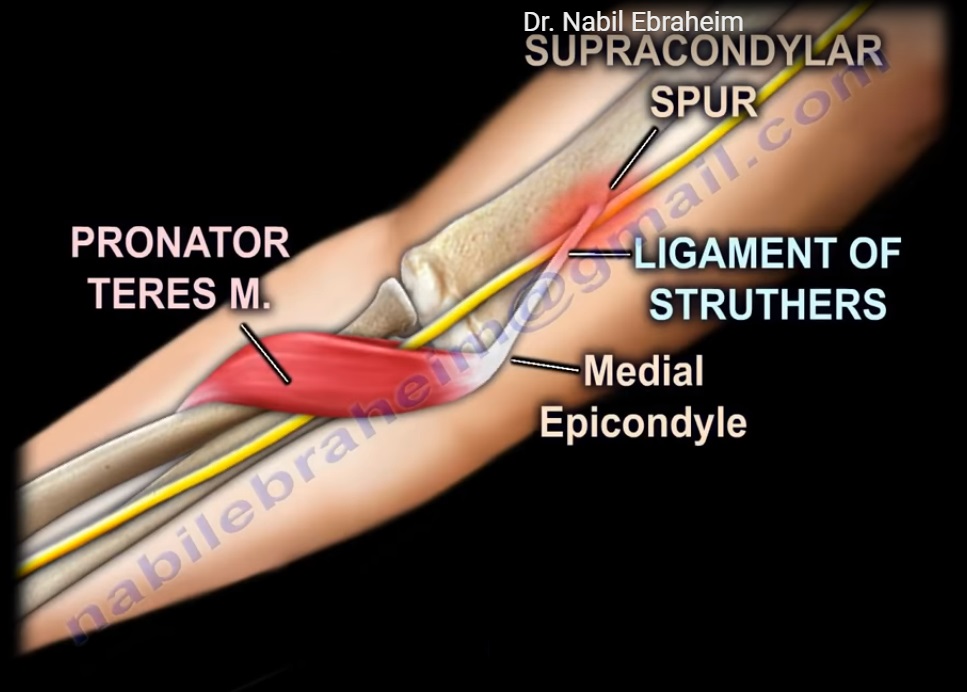Courtesy: Prof Nabil Ebraheim, University of Toledo, Ohio, USA
*Pronator Teres Syndrome*
- Pronator teres syndrome is a compression of the median nerve at the level of the elbow which occurs more in females.
- In the forearm, the median nerve runs between the two heads of the pronator teres muscle and then it lies between the flexor digitorum superficialis and flexor digitorum profundus muscles.
- Pronator teres syndrome could be associated with medial epicondylitis.
The principle symptoms of numbness in the radial
3 1/2 fingers as well as thenar weakness may be mistakenly attributed to carpal tunnel syndrome.
Potential sites for entrapment of the nerve include:
• Compression of the median nerve between the two heads of the pronator teres muscle (most common cause).
• It occurs in people who perform repetitive forceful pronation of the forearm.
• Compression due to thickening of the bicipital aponeurosis.
• The aponeurosis crosses from lateral to medial over the antecubital fossa and it may irritate the median nerve.
• Compression of the nerve from the fibrous arch of the origin of the flexor digitorum superficialis (FDS).
The median nerve runs down the medial side of the arm and passes 2 1/2 to 4 cm below the level of the medial epicondyle before it enters between the two heads of the pronator teres.
- About 1% of patients have a medial supracondylar humeral spur about 5 cm proximally to the medial epicondyle.
- The ligament of Struthers is attached to this bony projection which connects the process to the medial epicondyle..
- The bony process points towards the elbow joint. The median nerve can become compressed or entrapped by the supra-condylar spur and by the ligament of struthers.,..
- The ligament of struthers extends from the supracondylar process to the medial epicondyle.
- The ligament of struthers is different from the arcade of struthers, which deals with compression of the ulnar nerve around the elbow.
Clinical Presentation
- Paresthesia in the lateral 3 1/2 fingers may occur with compression of the median nerve at the elbow region or at the carpal tunnel region.
- Symptoms are similar to carpal tunnel syndrome but the symptoms are worse with rotation of the forearm ? 46%
- The patient will complain of dull aching pain over the proximal forearm with no night symptoms.
- The pain is usually worsened by repetitive or forceful pronation.
- Tenderness of palpation to the pronator teres muscle.
- The median nerve gives off a palmar cutaneous branch before entering the carpal tunnel.
- Sensory disturbances over the palm of the hand occur due to involvement of the palmar cutaneous branch of the medial nerve and this occurs proximal to the carpal tunnel.
EXAMINATION TESTS
TINELS & PHALENS TESTS : negative
- Median nerve compression tests are negative at carpal tunnel however positive at proximal forearm.
- There will be abnormal sensation in the palm
- When compression of nerve involves supracondylar process, the test is considered positive if symptoms of tingling worsen while tapping on the nerve. Occasionally the spur can be felt.
- Resisted forearm pronation with elbow extension will test for compression at the two heads of pronator teres muscle.
- Resisted elbow flexion with forearm supination ( indicates compression of median nerve at bicipital aponeurosiis)
- Resisted contraction of FDS to middle finger ( compression at FDS arch)
DIFFERENTIAL DIAGNOSIS
• C6 – C7 radiculopathy : Numbness of thumb, index and long fingers as well as weakness of muscles at forearm that are innervated by median nerve
• Carpal tunnel syndrome
TREATMENT
• Rest
• Splint
• NSAIDS
• Surgical decompression of median nerve through all 4 or 5 possible sites of compression when non operative management fails for 3 – 6 months
About 80%of patients improves with surgery

Leave a Reply